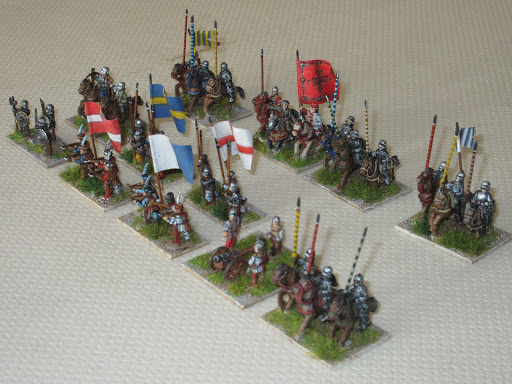The last Medieval German list
of 1494-1518 simulates the Imperial armies that fought against France in the
Low Countries and the Venetians in Norther Italy. Unfortunately, the same list
cannot be effectively be used for the internal conflicts between the city
states, ducal forces or those fielded by the Church.
The DBM army list for the
Medieval German Army does allow for this with armies representing the feudal
provinces, city states, or those led by clerical commanders. This took time to
recalculate the number of elements for each troop type and note the technical changes
in tactics and their weapons use.
Below are three proposed
lists that will be used for an upcoming campaign set in Northern Germany, the
time frame is not set buy should end by the first quarter of the 16th
century.
The Medieval German 1494-1518
1 x General & Guard (3Kn), 1 x Burgundian Gendarmes (3Kn) or Landsknechts (4Pk or 3Bd), 2 x Knights (6Kn), 1 x Crossbow cavalry (Cv), 4 x Landsknechts (4Pk), 2 x Handgunners (Ps), 1 x bombards (Art).
Knights (3Kn or 6Kn)
The double based element simulates the deep formation used by German heavy cavalry, at its head were the armoured nobles with rear ranks filled by lesser armoured men-at-arms. Eltis mentions the nobility organising themselves in associations and holding exclusive tournaments which maintained their martial skills but underscored their separation from other classes including the urban elite. After 1450, German heavy cavalry could form separate formations having the less armoured troops in cavalry (Cv) units. This will be listed as an option for those troops.
Crossbow cavalry (Cv)
In Slingshot 209 “The Medieval German Issue”, Viljana writes mounted crossbow performed a number of tasks which were better suited for light cavalry (LH), DBA3 lists them as cavalry (Cv). The difference may come from the German manual (Seldneck) describing them as capable of ‘falling on an enemy’s flank’. DBR have crossbow armed LH(S) for French, Italian and German Minor States of the same time period. The best solution is to them as either Cv or LH.
Crossbow (4Cb) and
archers (Ps)
Tournaments were held to test one’s skill with the crossbow or bow and this is well documented in “A Towns Defence in Medieval Germany”. Such weapons were an individual’s property and were required to be presented at the general mustering. Units so armed could still be found among the armies raised by cities and the church.
Mercenary pikemen
(4Pk) and Feudal retainers (7Hd)
By 1450, the pike had
replaced the spear throughout the Holy Roman Empire. Feudal retainers are
similarly armed but lack weapon skills and drill to be classed as 4Pk, so are
horde. Eltis relates the expense of hiring mercenaries and campaign rules
should reflect their rapacious behaviour. The quantity of mercenary pikemen
varies among the three proposed lists with a few electing to use the Heerban or
city militia as a viable alternative.
War waggons (WWg)
The German northern plain would be ideal terrain for their use, but the increase use of artillery would certainly lessen their use on the battlefield. The DBM list give feudal and clerical armies the use of war waggons and will remain so for this revised list.
City militia (4Cb)
Deploying city militia for
operations far from their home would risk a high rate of desertion and should
be a factor to be considered when developing a campaign rule set. Feudal
commanders would be less affected as handguns replaced the crossbow, but others
were slow to make the change clerical and city led armies).
Field Guns on wheeled carriages (Art)
Many cities and town did strengthen their fortifications with the addition of artillery pieces especially those fortunate enough to have their own foundries. With such resources it would be tempting to raise the quantity of models to two.
Conflicts Within The Empire
Using the DBM German list as a starting point, this can serve to create three possible lists ending with the reign of Maximilian. These are feudal (minor German states), city (independent city states) and clerical (Bremen, Utrecht). This would greatly aid the development of historical scenarios or a campaign set in empire during the period of the Italian Wars.
Feudal Army 1440 - 1518
1 x General (3Kn), 2 x feudal knights (6Kn or 3Kn or Cv), 1 x feudal mounted crossbowmen (Cv), 1 x feudal retainers pikemen (7Hd), 1 x feudal archers (Ps), 1 x mercenary handgunners (Ps), 4 x mercenary pikemen (4Pk), 1 x feudal bombards (Art)
City State Army 1440 - 1518
1 x General (6Kn or 3Kn), 2 x clerical knights (6Kn or Cv), 1 x mercenary mounted crossbowmen (Cv), 2 x city militia crossbowmen with pavises (4Cb), 2 x mercenary pikemen (4Pk), 2 x Heerban pikemen (7Hd), 1 x mercenary handgunners (Ps), 1 x city bombards (Art)
Clerical Army 1440 - 1518
1 x General (6kn or 3Kn), 2 x clerical knights (6Kn or Cv), 1 x mercenary mounted crossbowmen (Cv), 2 x city militia crossbowmen with pavises (4Cb), 1 x city militia halberdiers (4Bd), 2 x city militia pikemen (4Pk), 1 x Heerban pikemen (7Hd), 1 x city militia handgunners (Ps), 1 x city bombards (Art)
Mercenary Army 1440 - 1518
1 x general (6Kn or 4Pk), 2 x mercenary knights (6Kn or 3Kn or Cv), 1 x mercenary mounted crossbowmen (Cv), 5 x mercenary pikemen (4Pk), 2 x mercenary handgunners (Ps), 1 x light gun (Art)
References
Slingshot 179, The Cavalry
Wedge, Jim Webster
Slingshot 197, Late Medieval Sweden, Kent Hägglund
Slingshot 204, Russia 1425
– 1505, Michael Fredholm von Essen
Slingshot 209, The
Medieval German Issue, Susanna Viljana
Slingshot 237, Medieval
Polish Armies, Matt Haywood
Slingshot 239, The
Hapsburg-Burgundian Army of the Netherlands, Duncan Head
Towns and Defence in Later
Medieval Germany, David Eltis








